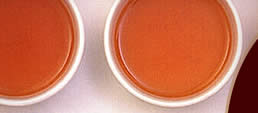 |
| |
The varieties of tea available that is
produced from Camellia Sinensis can be largely categorized
into Green Tea, Black Tea and Specialty White Teas.
Black Tea and Green Tea
Although it is commonly assumed that black and green tea
are produced from two different trees, they in fact come
from the same tree. The difference in the two types of
teas arises from the process of fermentation. During the
fermentation process tea turns red and then eventually
black when dried. Green tea in contrast is not fermented,
but is heat-treated to retain its colour.
No records are available on how and why the process of
fermentation was started. It is however possible that
the process was developed to store and preserve tea more
easily and retain it for longer periods of time.
While both green and black tea have their own distinctive
tastes, black tea grew in popularity throughout the world.
The number of ways in which black tea can be consumed
are varied and has therefore resulted in it being preferred
over green tea.
Terms describing
the grading of selected black teas
Pekoe – a whole leaf
black tea produced by a medium plucking of the second
leaf on the tea bush. The word Pekoe is derived from Chinese,
meaning ‘white hair’ and was originally applied
to early tea pluckings, due to the white down on the backs
of the young tea leaf.
Broken Orange Pekoe –
(BOP) black tea comprising smaller leaves and broken segments
with an abundance of tips. Can be applied to both Orthodox
and CTC teas.
Broken Pekoe
– (BP) full boiled black tea comprising broken segments
of somewhat coarse leaf, without tip. Can be applied to
both Orthodox and CTC teas.
Fannings – small grainy
particles of leaf (1-1.5mm) sifted out of better grade
teas. Fannings will produce a liquor that is often as
good as that of a whole leaf grade – it is a grade
which applies to both orthodox and CTC teas. In the orthodox
teas, fannings will include broken orange pekoe fannings
(BOPF) and golden orange pekoe fannings (GOPF), which
describe the amount of tips in a grade.
Flowery Orange Pekoe –
can be either whole leaf or broken leaf orthodox black
tea with a lot of tip, which gives its finer quality.
Flowery Pekoe –
a whole leaf black tea with the leaf rolled lengthwise.
Orange Pekoe – black
tea comprising leaf 8 to 15 millimeters long which has
fewer tips than an FOP.
Dust
– the smallest particle of leaf size in both
orthodox and CTC teas, which is normally used for tea
bags, as they infuse quickly with the full flavour and
strength coming through the tea bag material.
Terms describing the grading of selected green
teas
Chinese Type Gun Powder Special –
tiny particles of tea representing pellets. Generally
having a smokey character in the cup.
Young
Hysen – large particles of tea, approximately
three times the size of Gun Powder.
Green
Tea Fannings – similar to BOP Fannings, this
particular grade is suitable for tea bags.
Sencha – long leaf tea
which produces a delicate brew. |
| |
|
| |
Top
of the page |



